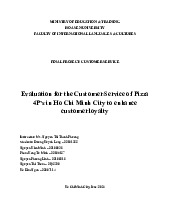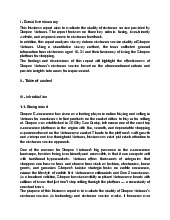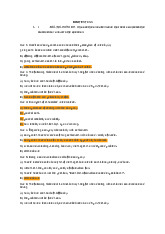
Preview text:
After reading the article “Elevating customer satisfaction and growth through service to solutions,"
I gained a lot of new insights about how businesses in today's era need to change their approach to
customer care rapidly. The article made me change my previous view that customer service is
mainly just solving complaints or supporting the temporary needs of customers. This article helped
me realize that, in order to create and maintain long-term customer connections, firms must adopt
a more proactive model rather than simply delivering reactive services.
One of the important points this article brings out is the context of the personalized experiences of
customers. For instance, Apple and Amazon have excelled in providing customized experiences at
every step of the customer’s journey. Not only do they give answers tailored to individual customer
requirements, but they also assist in anticipating future customer requirements and thereby raise
customer satisfaction and trust over the long term. One point of caution in this article is defined as
“service to solution .” This is a shift from a reactive customer service model to a more proactive
approach and more comprehensive advice. Instead of responding to customer concerns, businesses
need to understand customer needs and provide appropriate solutions for each customer. It is a
method not only to create long-term relationships but also a means of working out how to grow
that relationship with a customer over time, and bringing in more new customers.
However, businesses face many challenges in order to achieve this. On one hand, expensive
investments in technology are required to track and analyze customer behavior to personalize the
experience, On the other hand, frontline employees have to undergo tailored trainings so they can
not only respond but also to understand deeply and propose solutions suitable for each customer.
The article emphasizes that human-to-human interactions are still crucial in building customer trust
and engagement although technological automation has seen many advancements. One of the more
impactful points in the article was it pointed out that many businesses are still entrenched in the
old way of thinking, where efficiency is measured by metrics such as response speed or processing
cost, rather than the actual level of customer satisfaction. This leads to businesses being
disillusioned in thinking they are operating effectively while the reality is that customers are
feeling increasingly distant and not getting the care or attention that they need. The article not only
reflects the current trend but also provides a clear direction for businesses if they want to retain
customers and develop sustainably in an increasingly competitive environment. The shift from
“service” to “solution” is no longer an option, but a mandatory condition if businesses want to
survive and create a difference. Especially in the context of consumers having more and more
choices and wanting to be served uniquely, the ability to adapt quickly and take the customer as
the center is the key to success.
In conclusion, the article enabled me to better understand the key role played by customer service
strategy in the current era. Not only is it regarded as a supporting function, but also as an integral
part of business development strategy. Relying on concrete examples and detailed analysis, the
article makes me think more in terms of taking customers as the center in business activities.



